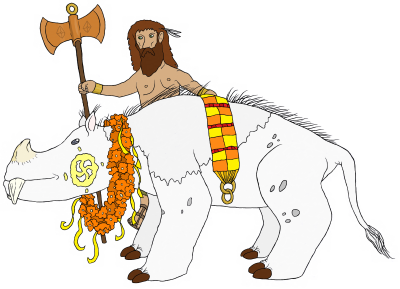Hyrnings
Hyrnings1 are among the largest herbivores on the Plain of Kings and the great plains of northern Dragonía in general, only Gírks are larger. They are native to the western edge of the Plain of Kings, but since their domestication by the early Mörkels they have spread throughout the region and as far south as the northern edge of Þrihakía.
Mörkels rely on hyrnings for a number of things, most importantly their meat and offal, milk (which is widely consumed after being fermented) and wool.
Mörkels rely on hyrnings for a number of things, most importantly their meat and offal, milk (which is widely consumed after being fermented) and wool.
Basic Information
Anatomy
Hyrnings are rather large, about the size of cattle, and their body-shape generally resembles that of (our world's) prehistoric toxodon, with thick hide covered in short fur of various shades of brown (males also sport bristles along the back), and three hooves on each foot. The fur become somewhat thicker during wintertime, and is shed afterwards. Males and females alike sport short tusks and a nasal horn, the former are used to dig up bulbs and tubers while the latter serve as their main weapon against predators. The males use the horns against each other during mating season as well.
Domesticated hyrnings are generally smaller than their ancestors, and have shorter tusks.
Domesticated hyrnings are generally smaller than their ancestors, and have shorter tusks.
Dietary Needs and Habits
Hyrnings live mostly on grasses, tubers and bulbs.
Additional Information
Social Structure
Hyrnings wild and domesticated alike tend to form herds, made up of several females with their calves and lead by a male. In the wild, the latter tend to chase away males from their own herd and are often challenged by outsiders, while their tamed counterparts are generally more tolerant.
Domestication
There are several varieties of domesticated hyrnings, all of which generally fall into two categories; short-haired, mostly raised for milk and meat, and woolly hyrnings which shed little to none of their winter coat.
Uses, Products & Exploitation
Hyrnings are the most important and widespread of all Mörkel livestock, as they provide them with such resources as meat, milk and wool. Practically all parts of the animals are used for something, including the dung, which is dried and either used as fertilizer or as fuel for the fire. Drinking cups made of carved hyrning tusks are commonly used by the aristocracy, and the animals themselves are sometimes given as offerings to the gods.
Geographic Origin and Distribution
Wild hyrnings were originally found in the region between the river Ett and the Fökan Hills on the western Plain of Kings, while domesticated ones are bred all over the plain and the northern edges of Þrihakía.
Perception and Sensory Capabilities
Hyrnings have poor hearing and even worse eyesight, so they mostly rely on their keen sense of smell.
1Original icelandic: hyrningar, singular: hyrningur
Origin/Ancestry
Western Plain of Kings
Body Tint, Colouring and Marking
Domesticated hyrnings are generally more colourful than their cousins out in the wild, ranging from grey to tan to ruddy, to nearly black or white, in addition to the more mundane brown tones. Irregular spots and splotches, whether paler or darker than the surrounding coat, are not uncommon, especially on the breeds near the coast of Narra'tonei Sea.
Related Materials




Comments